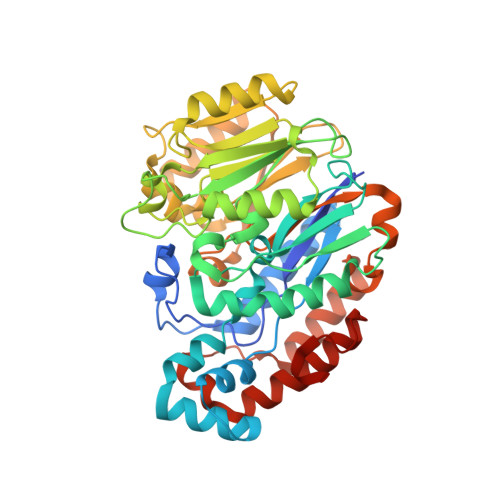Crystal structure of N-succinylarginine dihydrolase AstB, bound to substrate and product, an enzyme from the arginine catabolic pathway of Escherichia coli.
Tocilj, A., Schrag, J.D., Li, Y., Schneider, B.L., Reitzer, L., Matte, A., Cygler, M.(2005) J Biol Chem 280: 15800-15808
- PubMed: 15703173
- DOI: https://doi.org/10.1074/jbc.M413833200
- Primary Citation of Related Structures:
1YNF, 1YNH, 1YNI - PubMed Abstract:
The ammonia-producing arginine succinyltransferase pathway is the major pathway in Escherichia coli and related bacteria for arginine catabolism as a sole nitrogen source. This pathway consists of five steps, each catalyzed by a distinct enzyme. Here we report the crystal structure of N-succinylarginine dihydrolase AstB, the second enzyme of the arginine succinyltransferase pathway, providing the first structural insight into enzymes from this pathway. The enzyme exhibits a pseudo 5-fold symmetric alpha/beta propeller fold of circularly arranged betabetaalphabeta modules enclosing the active site. The crystal structure indicates clearly that this enzyme belongs to the amidinotransferase (AT) superfamily and that the active site contains a Cys-His-Glu triad characteristic of the AT superfamily. Structures of the complexes of AstB with the reaction product and a C365S mutant with bound the N-succinylarginine substrate suggest a catalytic mechanism that consists of two cycles of hydrolysis and ammonia release, with each cycle utilizing a mechanism similar to that proposed for arginine deiminases. Like other members of the AT superfamily of enzymes, AstB possesses a flexible loop that is disordered in the absence of substrate and assumes an ordered conformation upon substrate binding, shielding the ligand from the bulk solvent, thereby controlling substrate access and product release.
Organizational Affiliation:
Biotechnology Research Institute, Montréal, Québec H4P 2R2, Canada.
















